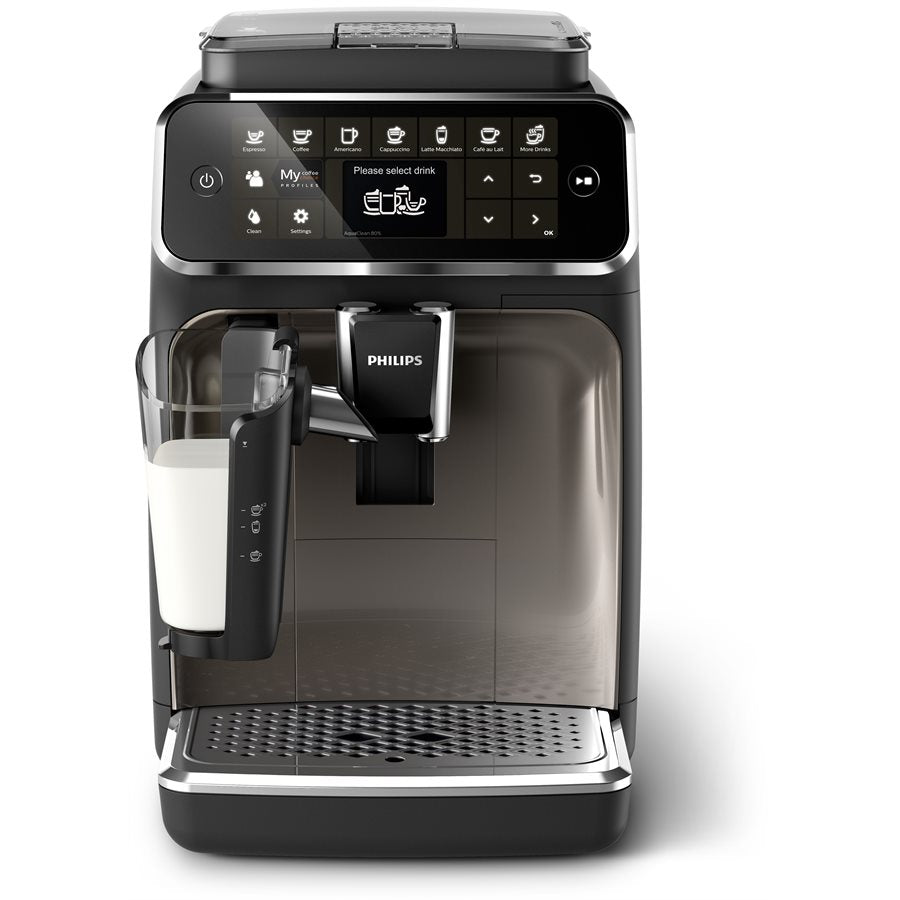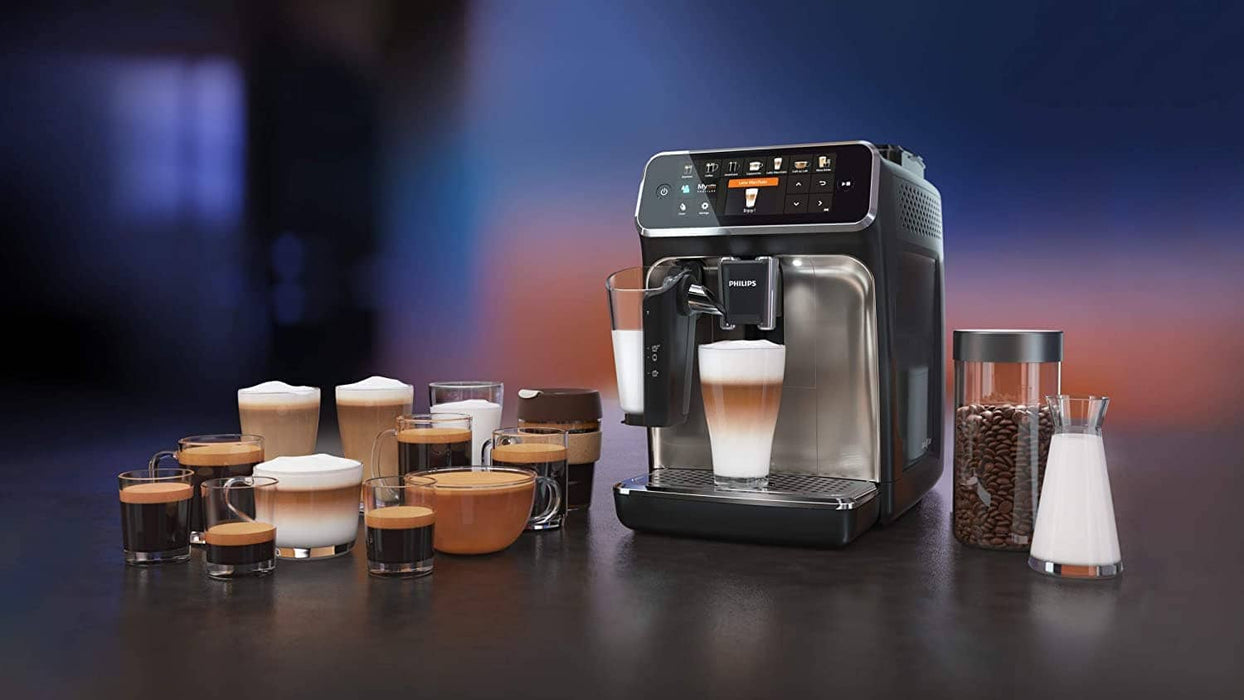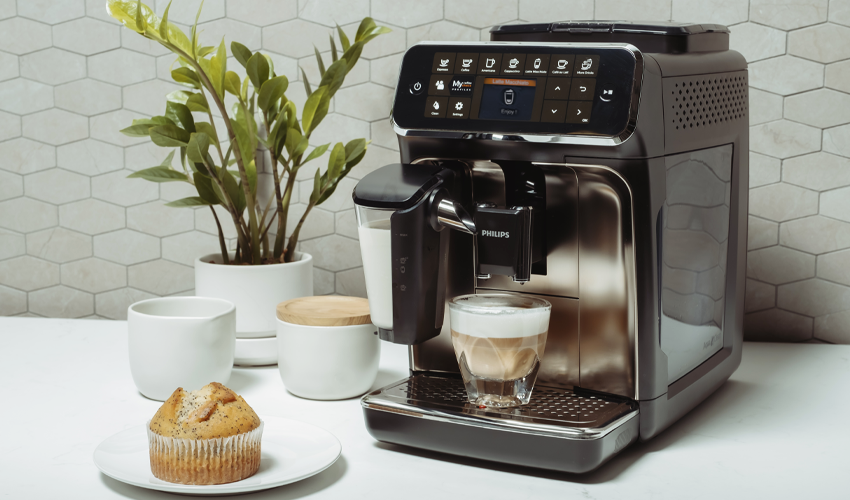#1: Philips LatteGo 5400

- Wide variety of drinks
- Advanced customization
- User profile options
#2: Philips LatteGo 4300

- Basic milk frother
- Small water tank
- Noisy grinder
As someone who treasures a good cup of coffee, finding the perfect espresso machine has always been a mission of mine. Over the years, I’ve tested a variety of coffee makers, from manual brewers to high-tech machines, but when I discovered the Philips LatteGo series, I knew I was stepping into a new realm of convenience and quality. In this article, I’ll be comparing two standout models, the Philips LatteGo 5400 and the 4300, and sharing my firsthand experience to help you make an informed decision.

My Coffee Routine: Why an Espresso Machine Matters
Like many coffee lovers, my day doesn’t start until I’ve had my first cup of coffee. Whether it’s a strong espresso to power through a busy morning or a creamy latte to enjoy during a relaxing afternoon, I value a machine that can deliver consistent results. I’ve owned the Philips LatteGo 5400 for a few months now, and before that, I had the chance to use the Philips LatteGo 4300 at a friend’s house. Comparing the two side by side has given me a deeper appreciation for the details that make the 5400 stand out.
Brewing Quality: Philips LatteGo 5400 vs 4300
it comes to brewing coffee, both machines produce exceptional results. Philips’ signature ceramic grinders ensure consistent grinding, preserving the natural flavors of the beans. However, I noticed a subtle difference in the intensity and depth of the espresso between the two machines.
The Philips LatteGo 5400 seems to extract slightly richer flavors, which might be due to its ability to fine-tune grind settings and water temperature more precisely. For someone like me, who enjoys experimenting with different beans and blends, this added precision makes a noticeable difference.
Variety and Customization: A Coffee Lover’s Dream
One of the reasons I was drawn to the Philips LatteGo 5400 was its versatility. While the Philips LatteGo 4300 offers an impressive eight drink options, the 5400 expands this menu to 12 beverages. This variety allows me to switch between a flat white and a café latte without feeling limited. On weekends, when I have guests over, I’ve found the additional options are a crowd-pleaser.
Another feature that stands out is the user profile system. The 4300 accommodates two profiles, which worked fine for my friend and their partner. However, in my household, where everyone has a different coffee preference, the 5400’s ability to store up to four profiles has been a game-changer.

Milk Frothing: A Key Difference
I can’t talk about these machines without mentioning the LatteGo milk system. Both models use the same innovative setup that combines ease of cleaning with excellent frothing capabilities. However, I’ve found that the Philips LatteGo 5400 delivers creamier, more velvety froth, which enhances drinks like cappuccinos and lattes.
This difference might not be apparent if you’re just starting with espresso machines, but as someone who enjoys a perfectly crafted latte, it’s a detail I’ve come to appreciate. I also love how quickly the LatteGo system can be rinsed—cleaning takes less than a minute, which is a lifesaver on busy mornings.
Ease of Use: Designed for Everyday Comfort
While both machines are user-friendly, the Philips LatteGo 5400’s interface stands out. The larger touchscreen with full-color icons makes selecting a drink incredibly straightforward. I’ve often found myself appreciating how intuitive the controls are, even when I’m half-asleep in the morning.
The 4300’s interface is functional, but the smaller display and simpler buttons feel a bit outdated compared to the 5400’s modern touchscreen. If aesthetics and convenience matter to you, this is another area where the 5400 excels.
Maintenance and Durability
One of the reasons I chose the Philips brand was its reputation for durability. Both machines are built to last, with ceramic grinders that are designed for up to 20,000 cups. However, the Philips LatteGo 5400 feels slightly more robust, particularly in the quality of its components.
it comes to cleaning, both machines make it effortless. The detachable LatteGo milk system and dishwasher-safe parts mean I spend less time scrubbing and more time enjoying my coffee. Additionally, the 5400 seems to require descaling less frequently, which is a small but appreciated advantage.

Who Should Choose the Philips LatteGo 4300?
While I prefer the 5400, the Philips LatteGo 4300 still has its merits. It’s more compact, making it ideal for smaller kitchens. If you’re a solo coffee drinker or live with just one other person, its two-user profile system and eight drink options might be more than sufficient.
Additionally, the 4300 comes at a lower price point, which is an attractive option if you’re looking to enter the world of fully automatic espresso machines without a hefty investment. It’s reliable, easy to use, and delivers a great cup of coffee.
Why I Recommend the Philips LatteGo 5400
After months of using the Philips LatteGo 5400, I can confidently say it’s the better choice for anyone who values variety, convenience, and top-tier quality. It’s a machine that adapts to your lifestyle, whether you’re making a quick espresso before heading out the door or preparing a round of specialty drinks for friends.
The additional beverage options, enhanced frothing system, and intuitive interface make it worth the investment. It’s not just a coffee machine—it’s a tool that brings café-quality drinks into your home. While the price is higher, the features and convenience it offers have made it a worthwhile purchase for me.
Conclusion: Is the Philips LatteGo 5400 Right for You?
Ultimately, the choice between the Philips LatteGo 5400 and 4300 depends on your needs. If you’re seeking an entry-level machine with excellent performance, the 4300 is a solid option. However, if you’re like me and want the ability to customize drinks, experiment with flavors, and enjoy a seamless user experience, the Philips LatteGo 5400 is the clear winner.
Investing in a high-quality espresso machine has elevated my coffee routine, and the 5400 has become an indispensable part of my day. Whether you’re a casual coffee drinker or a passionate enthusiast, this machine is designed to make every cup a delight.
Frequently Asked Questions: Philips LatteGo 5400 vs 4300
1. What’s the main difference between the Philips LatteGo 5400 and the 4300?
The primary difference is the number of beverage options and user profiles. The Philips LatteGo 5400 offers 12 drink options, including specialty drinks like flat white and café latte, while the 4300 offers 8. The 5400 also supports up to 4 user profiles, compared to the 4300’s 2 profiles.
2. Is the Philips LatteGo 5400 worth the higher price?
Yes, the Philips LatteGo 5400 is worth the investment if you value a wider variety of drinks, better milk frothing, and more user profiles for customization. It also has a more advanced touchscreen interface, which makes it easier to navigate and use.
3. Can I use both the 5400 and 4300 for making espresso?
Absolutely! Both models are capable of making high-quality espresso. The main difference is the additional customization options on the 5400, which may allow for slightly more tailored espresso shots based on your preferences.
4. How easy is it to clean the Philips LatteGo machines?
Both the 5400 and 4300 are designed for easy cleaning. The LatteGo milk system can be rinsed under water, and all removable parts are dishwasher safe. The 5400 also requires less frequent descaling, making maintenance a bit more convenient.
5. Can I make milk-based drinks like lattes and cappuccinos with these machines?
Yes, both models are equipped with the LatteGo milk frothing system, which makes creamy froth for lattes, cappuccinos, and other milk-based beverages. However, the 5400 produces slightly creamier and more consistent froth, making it ideal for those who enjoy milk-based drinks regularly.
6. What type of coffee beans should I use with the Philips LatteGo?
You can use any whole coffee beans you like, but it’s recommended to use high-quality, freshly roasted beans to get the best results. The ceramic grinders in both the 4300 and 5400 ensure that the beans are ground evenly, preserving the flavor.
7. How long does it take to brew a cup of coffee with these machines?
Both the Philips LatteGo 5400 and 4300 are quick and efficient. A standard espresso takes around 30 seconds to brew, while a milk-based drink like a cappuccino or latte takes about a minute, depending on the milk frothing process.
8. Are there any additional features on the 5400 that make it easier to use?
Yes, the 5400 comes with a larger, more intuitive touchscreen interface, which makes it easier to navigate the menu and select your desired drink. It also offers more user profiles, allowing for personalized settings for multiple users in the household.
9. Can I make large cups of coffee with the Philips LatteGo machines?
Yes, both models can accommodate larger cups. The 5400 even has a "travel mug" option, which allows you to brew a larger volume of coffee, perfect for on-the-go mornings.
10. How durable is the Philips LatteGo 5400 compared to the 4300?
Both machines are built to last with high-quality materials, but the 5400 feels slightly more robust and durable. The ceramic grinders are designed for up to 20,000 cups, ensuring longevity for both models. However, the 5400 may provide a more premium feel and longer-lasting performance due to its enhanced components.
